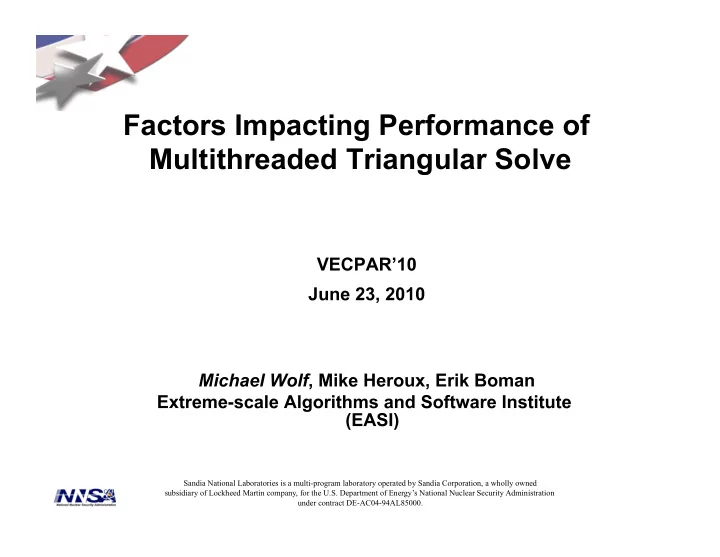

Factors Impacting Performance of Multithreaded Triangular Solve Sandia National Laboratories is a multi-program laboratory operated by Sandia Corporation, a wholly owned subsidiary of Lockheed Martin company, for the U.S. Department of Energy’s National Nuclear Security Administration under contract DE-AC04-94AL85000.
Motivation • Triangular solver is important numerical kernel – Essential role in preconditioning linear systems • Difficult algorithm to parallelize • Trend of increasing numbers of cores per socket • Threaded or hybrid approach potentially beneficial • Focus of work: threaded triangular solve on each node/socket 2
Motivation Strong scaling of Charon on TLCC (P. Lin, J. Shadid 2009 ) • Inflation in iteration count due to number of subdomains (MPI tasks) • With scalable threaded triangular solves – Solve triangular system on larger subdomains – Reduce number of subdomains (MPI tasks) 3
Level Set Triangular Solver L DAG • Initially, focus attention on level set triangular solver (J. Saltz, 1990) – Level set approach exposes parallelism • First, express data dependencies for triangular solve with a directed acyclic graph (DAG) 4
Level Set Triangular Solver • Determine level sets of this DAG – Represent sets of row operations that can be performed independently 5
Level Set Triangular Solver • Permuting matrix so that rows in a level set are contiguous – D i are diagonal matrices – Row operations in each level set can be performed independently 6
Level Set Triangular Solver • Resulting operations for triangle solve – Row operations in each level can be performed independently (parallel for) 7
Simple Prototype • Simple prototype of level set threaded triangular solve – Assumes fixed number of rows per level – Assumes matrices preordered by level – Pthreads • Allowed us to explore factors affecting performance • Run experiments on two platforms – Intel Nehalem: two 2.93 GHz quad-core Intel Xeon processors – AMD Istanbul: two 2.6 GHz six-core AMD Opteron processors 8
Factor 1: Type of Barrier • Implemented two different barriers – “Passive” barrier • Mutexes and conditional wait statements – “Active” barrier • Spin locks and active polling 9
Barriers Speedup Matrix Size • Results for good data locality matrices • Active/aggressive barriers essential for scalability 10
Factor 2: Thread Affinity • Studied the importance of thread affinity • Thread affinity allows threads to be pinned to cores – Less likely for threads to be switched (beneficial for cache utilization) – Ensures that threads are running on same socket 11
Thread Affinity Speedup Matrix Size • Results for good data locality matrices, active barrier • Thread affinity not as important as active barrier – But can be beneficial for some problem sizes 12
Factor 3: Data Locality Random “Good” data locality “Bad” data locality • Examined three different types of matrices – Same number of rows per level – Same number of nonzeros per row • Allowed us to explore how data locality affects performance 13
Data Locality: Good vs. Bad 1 2 4 8 # threads • Results for good (GD) vs. bad data (BD) locality matrices • Active barrier 14
Data Locality: Good vs. Bad Speedup Matrix Size • Results for good (GD) vs. bad data (BD) locality matrices • Active Barrier 15
Data Locality: Good vs. Random 1 2 4 8 # threads • Results for good data locality vs. random matrices • Active barrier 16
Data Locality: Good vs. Random Speedup Matrix Size • Results for good data locality (GD) vs. random (RN) matrices • Active Barrier 17
More Realistic Problems Name N nnz N / nlevels Application area asic680ks 682,712 2,329,176 13932.9 circuit simulation cage12 130,228 2,032,536 1973.2 DNA electrophoresis pkustk04 55,590 4,218,660 149.4 structural engineering bcsstk32 44,609 2,014,701 15.1 structural engineering • Symmetric matrices • Incomplete Cholesky factorization (no fill) • Average size of level important 18
Realistic Problems: Barriers Speedup • Problems with larger average level size scale fairly well • Active/aggressive barrier important 19
Realistic Problems: Thread Affinity Speedup • Problems with larger average level size scale fairly well • Thread affinity not particularly important 20
Level Set Triangular Solver Extension • Algorithm scales when average level size is high • Couple factors hurt performance for small average level size – Many levels, many synchronization points – Not enough work in small levels (barrier cost significant) • Implemented simple extension to address these problems – Serialize small levels below a certain threshold – Merge consecutive serialized levels – Reducing levels reduces synchronization points 21
Level Set Triangular Solver Extension Speedup Speedup Original Extension • Very slight improvement for problem that scale well – Not many small levels – Can reduce speedup if too aggressive in serialization 22
Level Set Triangular Solver Extension Speedup Speedup Original Extension • Slight improvement for problem that originally did not scale quite so well – More small levels 23
Level Set Triangular Solver Extension Speedup Speedup Original Extension • Significant improvement for problem that originally did not scale well – Many small levels – Great reduction in synchronization points • Still does not scale well for 8 threads 24
Summary/Conclusions • Presented threaded triangular solve algorithm – Level scheduling algorithm • Studied impact of three factors on performance – Barrier type most important • Good scalability for simple matrices and two realistic problems • Scalability related to average level size – Simple extension to improve results when level sizes are small – Better algorithms needed for matrices with small average level size • Algorithms being implemented in Trilinos – http://trilinos.sandia.gov 25
Recommend
More recommend